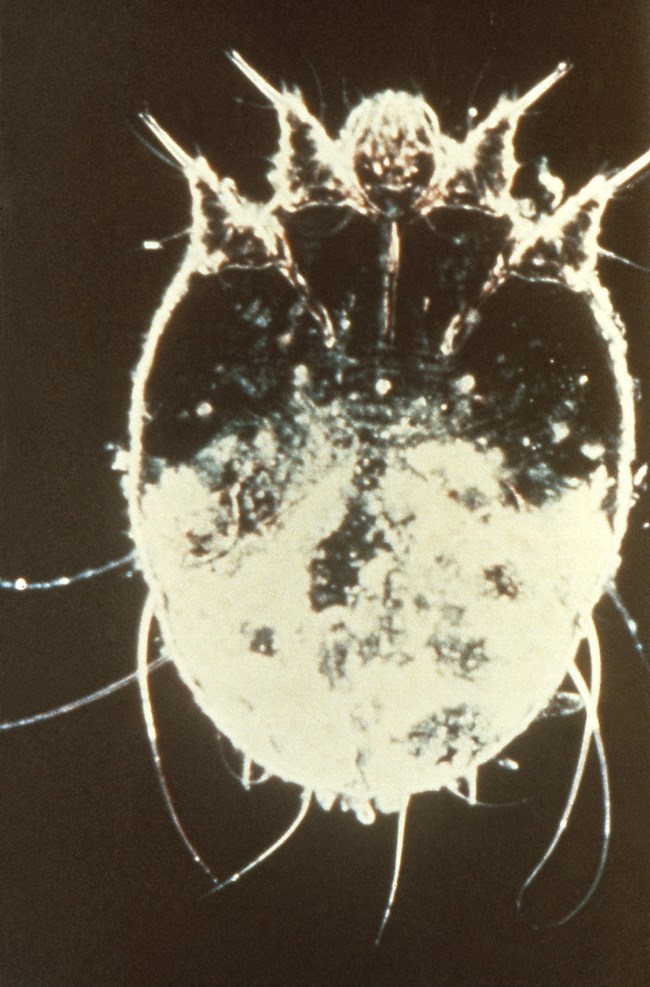Last updated: April 25, 2023
Article
Scabies
(This page is part of a series. For information on other illnesses that can affect NPS employees, volunteers, commercial use providers, and visitors, please see the NPS A–Z Health Topics index.)

CDC/Joe Miller/Reed & Carnrick Pharmaceuticals
Humans: Human scabies is a skin condition caused by the human itch mite (Sarcoptes scabei var. hominis). The mites burrow into the upper layer of a person’s skin where they complete their entire life cycle, including laying their eggs. Scabies occurs worldwide and can affect all people. It is transmitted through prolonged skin-to-skin contact with someone with scabies, sometimes even before their symptoms develop. Household members and sexual contacts are at particularly high risk. The mites can sometimes be spread indirectly by sharing items such as clothing, towels, or bedding that have been used by an infested person. The transmission risk is greater from persons who have the “crusted” (severe) form of scabies (which can occur among those who are immunocompromised) because the number of mites is much more numerous. The most common symptoms of scabies are intense itching (especially at night) and a pimple-like skin rash. In a person who has never had scabies before, symptoms may take as long as 4-6 weeks to begin. Symptoms can occur earlier (after 1–4 days) for those who have previously had scabies.
Animals: Animals are not infested with the human itch mite, but they can be infested with other variants or species of Sarcoptes mites, some of which can cause short-lived zoonotic infestations in humans. Animals with severe Sarcoptes mite infestations may develop hair loss (can be patchy or nearly complete), as well as skin lesions such as thickening and crusting. Animals with these clinical signs are referred to as having “mange.” Sarcoptic mange has been documented in at least 148 species of domestic and wild mammals, and infestations can be fatal and cause population declines. For example, in Yellowstone National Park, sarcoptic mange was noted as one factor that contributed to wolf population decline.
Environment: Human scabies infestations are most common in hot, tropical climates. On a person, scabies mites can live for as long as 1–2 months. Off a person, scabies mites usually do not survive >72 hours. Scabies mites will die if exposed to hot temperatures for 10 minutes.
PREVENTION
- Avoid skin-to-skin contact or sharing items such as clothing or bedding with a person known to have scabies.
- If you have had skin-to-contact with a person or share a household with a person with scabies, seek healthcare. Your doctor may prescribe prophylactic treatment.
- If you suspect you have scabies, seek healthcare for treatment. Additionally, household and sexual contacts within the preceding month should be examined and treated at the same time.
- Wear clean clothes after treatment.
- Machine-wash and dry on the hot cycle all bedding, clothing, and towels used by a person with scabies. Dry-cleaning is also an option. Items that cannot be washed or dry-cleaned should be removed from any human contact for least 72 hours.
- Vacuum furniture and carpets.
- Avoid the use of insecticide sprays and fumigants.
- Return to school or work based on guidance from your doctor or local health department. In general, if there is no additional guidance, people can return to school/work the day after treatment.
- Consult with a veterinarian regarding treatment of mange in domestic animals.
- Report concerns about sick or dead wildlife to the park resource manager and the Wildlife Health Branch immediately.

NPS
